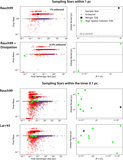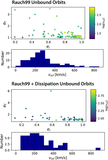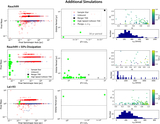Image Details

Caption: Figure 1.
Upper panel: we plot the relevant timescales as a function of distance from the SMBH for a range of stellar density profiles, α = 1.25 (dashed line) to α = 1.75 (solid line). The collision and relaxation timescales are in red and blue, respectively, while the gray line marks the total simulation time of 10 Gyr. The vertical red line emphasizes the radius at which the collision timescale equals the simulation time; within this radius, collisions are common and shape the evolution of the stars and cluster. We also mark the radius at which the velocity dispersion is approximately the escape speed from the surface of a Sun-like star using the green vertical line. External to this radius, we expect collisions to result in mergers. Lower panel: we consider a hyperbolic encounter between two stars in the cluster. This plot shows the impact parameter in solar radii for a 90∘ deflection as a function of the relative speed between the stars. Note that the x-axis is inverted to reflect the dependence of velocity dispersion on distance from the SMBH; it parallels the x-axis of the plot above, with the largest velocities occurring near the SMBH and decreasing further out. We have marked the speeds that correspond to the inner and outer allowed initial semimajor axes of the stars in our sample, 0.001 and 1 pc, respectively. Additionally, we mark where b90 becomes equal to the star’s radius. This point coincides well with the speed at which we would expect the collision outcome to transition from mergers to the sorts of high-speed encounters that might strip or destroy stars but leave them unbound from each other.
Copyright and Terms & Conditions
© 2025. The Author(s). Published by the American Astronomical Society.








